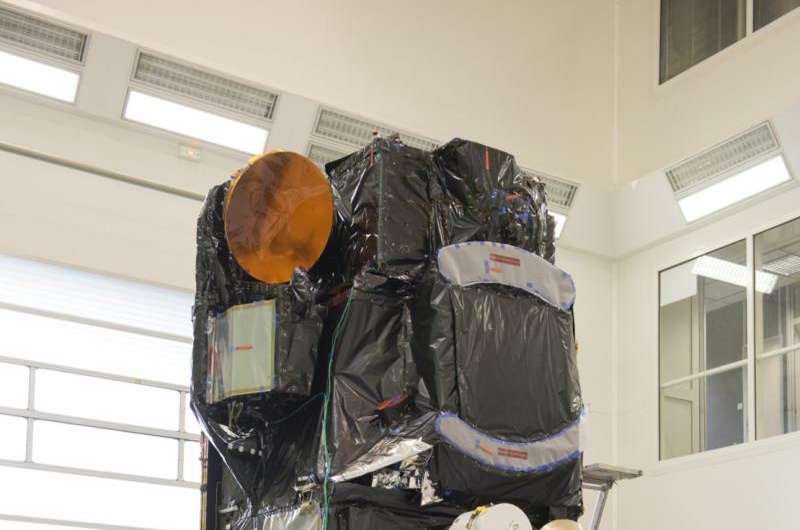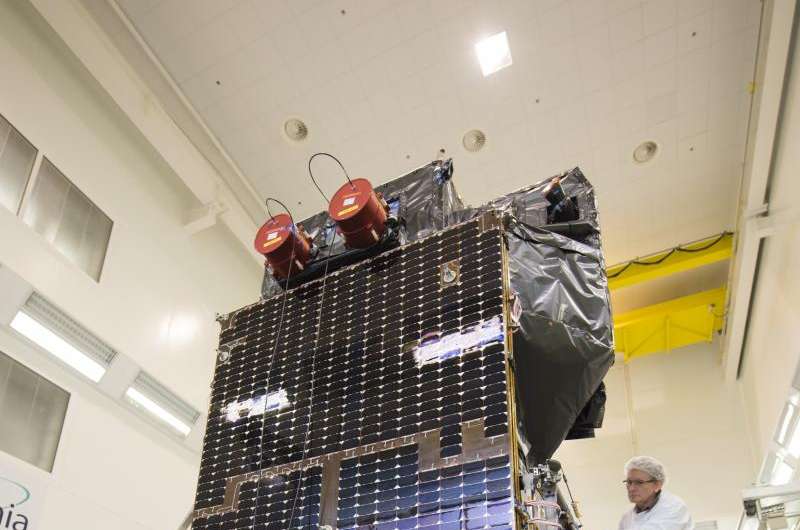Sentinel-3A shows off

Before the latest satellite for Copernicus is packed up and shipped to the Plesetsk cosmodrome in Russia for launch at the end of the year, the media and specialists were given the chance to see this next-generation mission centre-stage in the cleanroom.
Carrying a suite of state-of-the-art instruments, Sentinel-3 is set to play a key role in the world's largest environmental monitoring programme – Copernicus.
The event was hosted by Thales Alenia Space in Cannes, France, where engineers have spent the last few years building and testing Sentinel-3A.
Thales' Sentinel-3 project manager, Yvan Baillion, said, "After eight years of development, integration and testing with more than 100 companies involved, it is wonderful to see this complex satellite standing proud and ready to be shipped off to the launch site."
"Sentinel-3A's multi-instrument payload, covering both optical and microwave measurements and serving a wide range of practical applications, is going to be the workhorse for Copernicus," added Bruno Berruti, ESA's project manager.
Building on the highly successful Envisat and CryoSat satellites, Sentinel-3A's sensors will measure different aspects of ocean waters, such as changes in the temperature and height of the sea surface – information that is needed for ocean forecasting and maritime safety. Around the coasts, this is also important for predicting extreme events such as storm surges and floods.
Ocean colour offers the means to monitor seawater quality and pollution. Applications using data acquired over land include fire detection and land-cover mapping.
This multitalented satellite also provides information to map the topography and extent of ice and to monitor the height of lake and river water.
At the event, ESA's Director of Earth Observation Programmes, Volker Liebig, said, "This new satellite, with its range of instruments, is an important complement to its sister satellites, Sentinel-1A and Sentinel-2A.
"With a focus on ocean surfaces, it will bring great benefit, especially to all Ocean Services of Copernicus. It will also feed the science community with the long-expected continuation of essential measurements started with ERS and Envisat."
Andras Roboz, from the European Commission, emphasised the user-driven nature of Copernicus, and the importance of the Copernicus services to serve policymakers and the various user communities. "Another cornerstone for Copernicus has been laid today. The wealth of data stemming from this mission will make an unprecedented step forward for the marine, climate change, atmosphere and land services."

Susanne Mecklenburg, ESA's Sentinel-3 mission manager, added, "We are looking forward to providing these valuable data to our users, including Copernicus core services.
"We have put in place all facilities, such as receiving stations and processing and archiving centres, to support the day-to-day operations, which will be shared by ESA and Eumetsat."
Sentinel-3A will be shipped to the Plesetsk launch site on 27 October. Once there, it will be thoroughly tested and prepared for launch in December.
Provided by European Space Agency




















